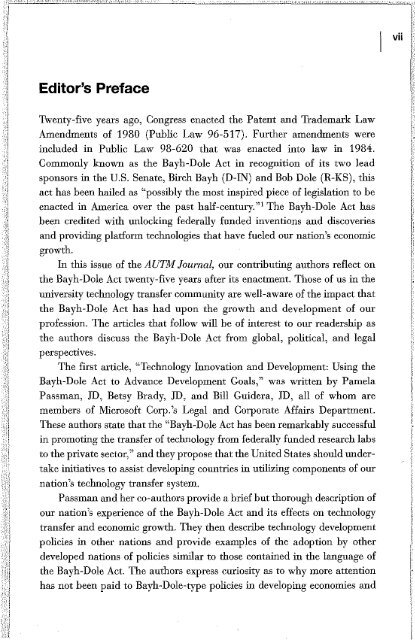~Iri,n - Bayhdolecentral
~Iri,n - Bayhdolecentral
~Iri,n - Bayhdolecentral
Create successful ePaper yourself
Turn your PDF publications into a flip-book with our unique Google optimized e-Paper software.
Editor's Preface<br />
Twenty-five years ago, Congress enacted the Patent and Trademark Law<br />
Amendments of 1980 (Public Law 96-517). Further amendments were<br />
included in Public Law 98-620 that was enacted into law in 1984.<br />
Commonly known as the Bayh-Dole Act in recognition of its two lead<br />
sponsors in the U.S. Senate, Birch Bayh (D-IN) and Bob Dole (R-KS), this<br />
act has been hailed as "possibly the most inspired piece of legislation to be<br />
enacted in America over the past half-century.'" The Bayh-Dole Act has<br />
been credited with unlocking federally funded inventions and discoveries<br />
and providing platform technologies that have fueled our nation's economic<br />
growth.<br />
In this issue of the AUTMJournal, our contributing authors reflect on<br />
the Bayh-Dole Act twenty-five years after its enactment. Those of us in the<br />
university technology transfer community are well-aware of the impact that<br />
the Bayh-Dole Act has had upon the growth and development of our<br />
profession. The articles that follow will be of interest to our readership as<br />
the authors discuss the Bayh-Dole Act from global, political, and legal<br />
perspectives.<br />
The first article, "Technology Innovation and Development: Using the<br />
Bayh-Dole Act to Advance Development Goals," was written by Pamela<br />
Passman, JD, Betsy Brady, !D. and Bill Guidera, JD, all of whom are<br />
members of Microsoft Corp.'s Legal and Corporate Affairs Department.<br />
These authors state that the "Bayh-Dole Act has been remarkably successful<br />
in promoting the transfer of technology from federally funded research labs<br />
to the private sector," and they propose that the United States should under<br />
take initiatives to assist developing countries in utilizing components of our<br />
nation's technology transfer system.<br />
Passman and her co-authors provide a brief but thorough description of<br />
our nation's experience of the Bayh-Dole Act and its effects on technology<br />
transfer and economic growth. They then describe technology development<br />
policies in other nations and provide examples of the adoption by other<br />
developed nations of policies similar to those contained in the language of<br />
the Bayh-Dole Act. The authors express curiosity as to why more attention<br />
has not been paid to Bayh-Dole-type policies in developing economies and<br />
vii
















